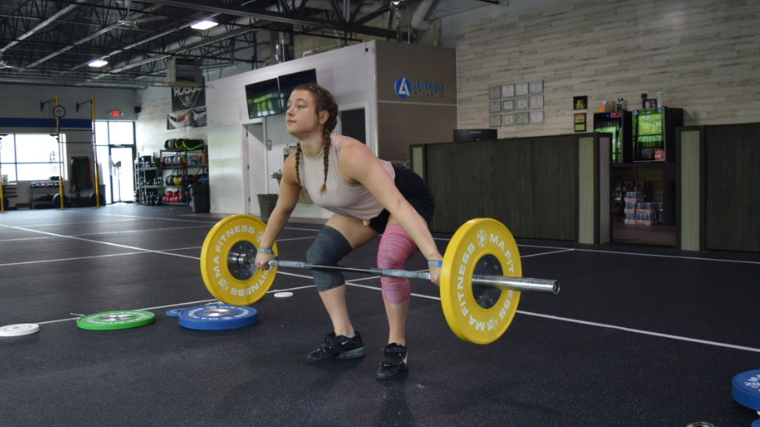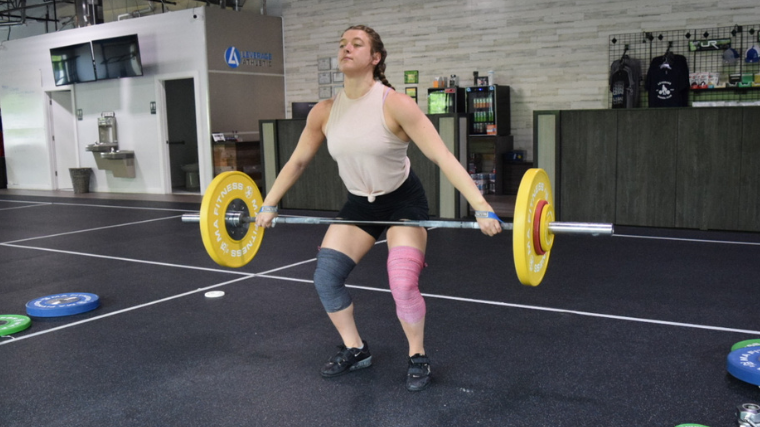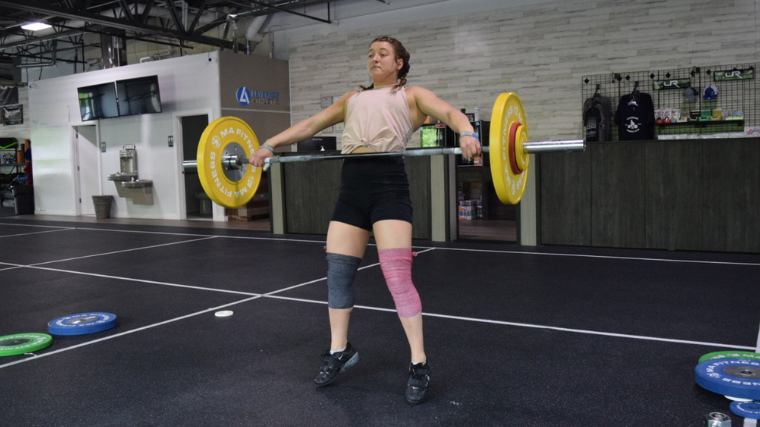The sport of Olympic lifting is all about taking flight. Unlike its competitive cousins powerlifting and strongman, weightlifting demands that you move dynamically with a loaded barbell at very high velocities from start to finish.
At the core of that sport-specific demand is your ability — or, rather, the necessity — to pull yourself under a barbell that is traveling upward. This mystical movement is how weightlifters appear to “teleport” under their bars in the blink of an eye. But, like most things in strength sports, it’s much easier said than done.

If you can get your “pull-under” right, though, your lifts will fly up as fast as your barbell does. Here are a few tips to improve the pull-under phase of your snatch and clean & jerk, as well as some bonus accessory exercises that can help drive the point home.
Tips to Pull Under the Bar
Get the Technique Right
The two lifts of weightlifting are the snatch and the clean & jerk. In both lifts, you have to pull yourself under the barbell to catch it. Part of what keeps you busy in weightlifting is that the advanced techniques are difficult to learn and even harder to master.
There’s a very exact way to do the so-called pull-and-catch. The technique is specially designed to help you lift the most weight. The first handful of times you do the lifts, the odds of doing it perfectly are slim.
You have to practice the right way to do each lift so that pulling under the bar becomes precise and efficient.
Why It Works
Your pull from the floor is what sets you up for success later on in the lift. Your most crucial task is to stand all the way up, or “extend”, before pulling your torso down under your bar. You’ll have a better chance of pulling yourself under a heavy bar if you elevate it as high as possible first.
Traveling under the bar and catching it smoothly happens fast. To do this part right, you have to practice the lifts weekly. The best lifters achieve their heaviest lifts from disciplined repetition of the technique.
Do More Squats
The purpose of pulling under the bar is to catch it in a deep squat. For example, in the clean, you pull the barbell from the floor to a front squat position. In the snatch, you pull under the barbell to an overhead squat. You have to be ready to squat the lift up once you catch it. For a stronger recovery, do more squats in your training.
Why It Works
Doing the squat builds integrity and strength in the receiving position of the lifts. It also helps you practice your full range of motion so that you’ll be ready to drop low under the bar.
In general, doing more squats of all kinds gives you better leg strength. This means you can elevate your barbell a little higher than before, but also ensures you have enough strength to stand up with it as well.
Fix Your Timing
Even though the lifts happen fast, they don’t happen all at once. The snatch and clean are performed in a rapid sequence. Each part has its own speed and cadence; you have to be fast all over, but especially when the bar is nearing your hip.
You’ll pull under the bar more forcefully if you “save your speed” for the right moment.
Why It Works
Proper timing is all about how fast you pull, and when. The first pull from the floor around the knee is controlled so that the bar stays close to you. After you pass the knee, you speed up your lift to increase your power output.
You should accelerate after the bar passes knee level such that you’re moving as fast as you can into triple extension, where your lower body pushes into the floor and imparts force onto the bar.
Doing so allows you to get the most height on the bar for the pull underneath. Avoid rushing through the first portion of your lift so that your pull under the bar can be abrupt and aggressive.
Use Your Arms
In addition to explosively contracting your lower body while you snatch or clean, your arms need to pull aggressively on the bar as well. You have to use your legs too of course, but your arms put a ton of the speed on the bar.
Your arms help put the lift where it needs to go when it matters (over your head or into the front rack position), so training this part of the lift is critical.
Why It Works
Your arms help guide the barbell into the right spot and hold it in place. Although the weights you’ll use in Olympic lifting are typically far heavier than what you could curl or press with just your arms, your upper body can guide an already-in-motion barbell into the correct place.
In addition, once your barbell is heavy enough (think heavier than your body weight), you can actually use it as a “fixed” object and pull yourself down into a squatting position.
Do More Partial Lifts
A lot happens in the lifts in the blink of an eye. Luckily, you can break them down and practice the different stages on their own. Doing so lets you practice pulling under a barbell specifically, without having to worry about the other phases of the movement.
There are a few different ways to do just the pull-under phase of the snatch or clean, such as lifting from the blocks or from the hang.
Why It Works
Both the snatch and the clean involve a long upward pull followed by a pull under. When you start the lift above knee height (by resting your barbell on blocks or hinging over from a standing position), you can cut out the first half of the technique.
Doing “partials” allows you to zone-in on the part of the technique that may matter most — reaching a full and explosive extension, and then actively pulling yourself down to your receiving position. Giving this area some extra attention will build your confidence in the full lifts later on.
Best Accessory Exercises for Pulling Under the Bar
When it comes to pulling under the bar better, there are certain exercises that can help you more than others. These are the best drills for working your “third pull.”
Snatch or Clean from Blocks
Lifting from the blocks is identical to the standard versions of the lifts, with the key facet being that you aren’t resting your barbell on the floor. You start above the knee so that you can focus on just the extension and pull underneath.
Benefits of the Snatch/Clean from Blocks
- It focuses on the technique of your lift from above the knee.
- You can typically add more weight (if desired) when the first pull is eliminated.
- You can adjust the height of the start of your lift to your preference.
How to Do the Snatch or Clean from Blocks
For the snatch and clean from the blocks, you need a pair of blocks. Weightlifting blocks (made of wood, plastic, foam, or metal) go under each side of the barbell to elevate the starting height of your bar.
Set up the blocks at your desired height and place the loaded barbell on them. Find the start position of your lift similar to how you would look if lifting from the floor. Whether you’re doing the snatch or the clean, pull your lift from the blocks to a strong and quick catch.
Three-Position Snatch or Clean
Another way to practice your pull-under is by going from the hang. A “hang” lift is when you start with the barbell at the hip while standing tall.
You first descend the bar down your legs, then change direction and extend as you normally would. The three-position complex is a series of drills done from varying hang heights.
Benefits of the Three-Position Snatch or Clean
- The various starting heights trains the quality of your pull at different ranges.
- Doing multiple reps amounts to extra technique practice.
- Gradually lengthening your pull by hanging lower and lower transfers the technique benefits to your full lift.
How to Do the Three-Position Snatch or Clean
A three-position snatch or clean consists of three repetitions performed back to back. Start by taking the barbell to a standing position with straight legs.
From here, “hang” down a few inches until the bar is resting gently against your upper thigh, and then extend normally. Afterward, recover and hang again, this time down to about the height of your kneecap.
After completing that rep, recover one final time and hang low, below the knee, but not so low that the barbell touches the ground.
Tall Snatch or Clean
Working your pull under the bar can sometimes mean practicing just that part by itself. The tall snatch and the tall clean are great exercises for just that. In this technique drill, you remove almost all upward travel on the bar, forcing you to drop down fast.
Benefits of the Tall Snatch or Clean
- You learn to generate speed without momentum from starting on the floor.
- It makes your pull under the barbell more punchy and abrupt.
- It helps you get more comfortable in the catch position.
How to Do the Tall Snatch or Clean
The tall snatch or clean starts in a standing position with straight and relaxed arms. Since you can’t bend your legs or hinge your hips, you should work with just the barbell at first.
If you’re performing the tall snatch, pull the bar upward with your arms while extending onto the balls of your feet. Then, sink quickly down into an overhead squat.
For the tall clean, move the same way, but simultaneously pull your hips down while racking the bar onto your shoulders in a front squat posture.
What Are the Three “Pulls”?
There are generally considered to be three distinct phases to the “pulling” portion of the snatch or clean, each with their own unique technical demands.
The First Pull
The first pull starts the moment the barbell leaves the floor. Your first pull begins by pushing with your quads to elevate the bar past your knees, and the first pull ends when your knees stop straightening and begin to re-bend — the infamous “double knee bend.”
The purpose here is to bring the barbell around the knee and set you up for success later on, so it has to be tight and controlled. Your chest and hips should rise at the same rate in your first pull, without your legs or back overpowering each other.
The Second Pull
Sometime after you clear the knees with the bar, the second pull starts. Your torso moves upright here as you readjust and pull the bar into your hip (or upper thigh, if you’re cleaning).
The motion of the second pull begins when your knees track forward again as your shoulders move up and back, and continues until you reach your tallest posture at the top of your extension. The purpose of the second pull is all about imparting as much vertical motion into the barbell as you can.
The Third Pull
The third pull is where the magic happens — it’s how you translate from an extended, upright position into a deep squat.
Your arms pull your body under the bar to catch it after you’ve used your legs to drive it high. This part of the lift has to be fast, and you have to be ready to “receive” the barbell once it stops flying.
Get Down With It
There’s a lot that goes on in the Olympic lifts, but with enough technique practice, you can do them right. The pull under the barbell is where you have to be the most precise, so you should prioritize working on it in your weekly routine.
You have to pull under the bar in all of your lifts (snatches, cleans, and even jerks depending on your style). Luckily, weightlifting is one of those sports where effort and time pays dividends. Working on your third pull will make you a more proficient, and efficient, athlete. Which is a surprisingly effective way of getting stronger on the platform.
Featured Image: Riley Stefan


